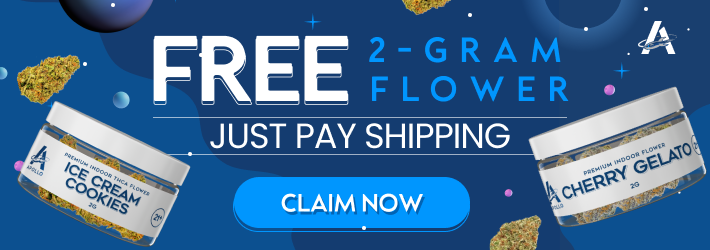You’ve probably heard of people using lavender aromatherapy or essential oils in a spa, salon, yoga, workplace, or just at home to relax.
A main active ingredient in them is a floral terpene called linalool, which is particularly known for relieving stress, anxiety, and more.
Key Takeaways:
- Linalool is one of the eight most common terpenes in Cannabis and lends a flowery, lavender aroma.
- The potential effects of linalool include symptomatic relief of anxiety, depression, pain, insomnia, restlessness, and agitation.
Characteristics of Linalool
While the name is not familiar to most people, you’d recognize linalool by its signature, clean aroma of lavender, flowers, and roses, with hints of lemon and woodiness.
Aside from being one of the eight most common cannabis terpenes, it’s abundant in many common natural sources including:
- Lavender
- Sweet basil
- Purple basil
- Eucalyptus
- Cinnamon
- Coriander
- Mint
- Bergamot Oranges
- Frankincense
Linalool helps plants like these communicate with each other and their environment. By releasing linalool into the air, plants can attract a wide range of pollinators, including bees and moths.
Some pollinators even have a distinct preference for linalool. Simultaneously, linalool can also repel insects, pests, herbivores, and pathogens like fungi and bacteria.
Cannabis Strains High in Linalool
There are many chemovars, or strains, that are typically high in linalool. These include:
- Purple Kush
- White Cookies
- Valley Fire
- Fire OG
- Diamond Girl
- Trainwreck
- LA Confidential
- Conspiracy Kush
- Jilly Bean
- Jack Cleaner 2
- Jack Skellington
- Nordle
- Nurse Jackie
Don’t worry if you can’t find one of these nearby. If you ask your local dispensary staff, they can help you find linalool-rich strains they have in stock using their certificates of analysis, or COAs.
Linalool’s Effects
Linalool is best known for its calming and anxiety-relieving effects.
People enjoy using linalool because it helps them relieve stress or fall asleep at night. It may also increase THC’s high.
All in all, you may find that linalool’s effects provide:
- Reduced anxiety
- Antidepressant effects
- Increased work productivity
- Stress reduction
- Sleepiness
- Calming
- Pain relief
Therapeutic Benefits of Using Linalool
Linalool hits many key receptors that cause these effects and overlap with potential therapeutic benefits.
For example, the same receptors that relieve anxiety (GABA) can also be anticonvulsant and sedating in increasing doses. This means it could help with seizures and sleeping issues.
Most of the evidence is limited to animal studies, but several clinical studies showed OTC Silexan® was as effective for anxiety as paroxetine, an antidepressant.
Linalool also shows significant pain-relieving activity and anti-inflammatory properties in animal models as well as small clinical studies. The linalool in lavender aromatherapy was able to reduce the need for opioids immediately after surgery in a small set of patients.
Beyond these, linalool may be:
- Antioxidant
- Pro-cognitive
- Neuroprotective
- Anticancer agent
- Chemo-synergistic
Side Effects
High-dose linalool in Silexan® may cause fatigue and gastrointestinal symptoms in 1-10% of people, such as:
- Nausea
- Diarrhea
- Bad breath
- Burping
Isolated linalool can cause eye, skin, and respiratory irritation. It may also trigger an allergic reaction in susceptible people. Avoid ingesting undiluted, concentrated forms of linalool. Natural Cannabis is much lower in linalool than lab-made formulations.
Related:
References
- Benavides, A. (2022, July 21). Linalool—Terpenes and Cannabinoid Research. Cannakeys. https://cannakeys.com/linalool-terpene-research/
- Booth, J. K., Yuen, M. M. S., Jancsik, S., Madilao, L. L., Page, J. E., & Bohlmann, J. (2020). Terpene Synthases and Terpene Variation in Cannabis sativa1[OPEN]. Plant Physiology, 184(1), 130–147. https://doi.org/10.1104/pp.20.00593
- Cox-Georgian, D., Ramadoss, N., Dona, C., & Basu, C. (2019). Therapeutic and Medicinal Uses of Terpenes. Medicinal Plants, 333–359. https://doi.org/10.1007/978-3-030-31269-5_15
- de Cássia da Silveira e Sá, R., Lima, T. C., da Nóbrega, F. R., de Brito, A. E. M., & de Sousa, D. P. (2017). Analgesic-Like Activity of Essential Oil Constituents: An Update. International Journal of Molecular Sciences, 18(12), 2392. https://doi.org/10.3390/ijms18122392
- Huang, L., & Capdevila, L. (2017). Aromatherapy Improves Work Performance Through Balancing the Autonomic Nervous System. Journal of Alternative and Complementary Medicine (New York, N.Y.), 23(3), 214–221. https://doi.org/10.1089/acm.2016.0061
- Kim, J. T., Ren, C. J., Fielding, G. A., Pitti, A., Kasumi, T., Wajda, M., Lebovits, A., & Bekker, A. (2007). Treatment with lavender aromatherapy in the post-anesthesia care unit reduces opioid requirements of morbidly obese patients undergoing laparoscopic adjustable gastric banding. Obesity Surgery, 17(7), 920–925. https://doi.org/10.1007/s11695-007-9170-7
- Liktor-Busa, E., Keresztes, A., LaVigne, J., Streicher, J. M., & Largent-Milnes, T. M. (2021). Analgesic Potential of Terpenes Derived from Cannabis sativa. Pharmacological Reviews, 73(4), 1269–1297. https://doi.org/10.1124/pharmrev.120.000046
- Raz, N., Eyal, A. M., Zeitouni, D. B., Hen-Shoval, D., Davidson, E. M., Danieli, A., Tauber, M., & Ben-Chaim, Y. (2023). Selected cannabis terpenes synergize with THC to produce increased CB1 receptor activation. Biochemical Pharmacology, 212, 115548. https://doi.org/10.1016/j.bcp.2023.115548
- Russo, E. B. (2011). Taming THC: Potential cannabis synergy and phytocannabinoid-terpenoid entourage effects. British Journal of Pharmacology, 163(7), 1344–1364. https://doi.org/10.1111/j.1476-5381.2011.01238.x
- Russo, E. B. (2019). The Case for the Entourage Effect and Conventional Breeding of Clinical Cannabis: No “Strain,” No Gain. Frontiers in Plant Science, 9. https://doi.org/10.3389/fpls.2018.01969
- Sommano, S. R., Chittasupho, C., Ruksiriwanich, W., & Jantrawut, P. (2020). The Cannabis Terpenes. Molecules, 25(24), 5792. https://doi.org/10.3390/molecules25245792
- Tomko, A. M., Whynot, E. G., Ellis, L. D., & Dupré, D. J. (2020). Anti-Cancer Potential of Cannabinoids, Terpenes, and Flavonoids Present in Cannabis. Cancers, 12(7), 1985. https://doi.org/10.3390/cancers12071985
- Weston-Green, K., Clunas, H., & Jimenez Naranjo, C. (2021). A Review of the Potential Use of Pinene and Linalool as Terpene-Based Medicines for Brain Health: Discovering Novel Therapeutics in the Flavours and Fragrances of Cannabis. Frontiers in Psychiatry, 12, 583211. https://doi.org/10.3389/fpsyt.2021.583211
- Wróblewska-Łuczka, P., Cabaj, J., Bargieł, J., & Łuszczki, J. J. (2023). Anticancer effect of terpenes: Focus on malignant melanoma. Pharmacological Reports, 75(5), 1115–1125. https://doi.org/10.1007/s43440-023-00512-1
- Zhang, L., Su, Q.-F., Wang, L.-S., Lv, M.-W., Hou, Y.-X., & Li, S.-S. (2023). Linalool: A ubiquitous floral volatile mediating the communication between plants and insects. Journal of Systematics and Evolution, 61(3), 538–549. https://doi.org/10.1111/jse.12930

